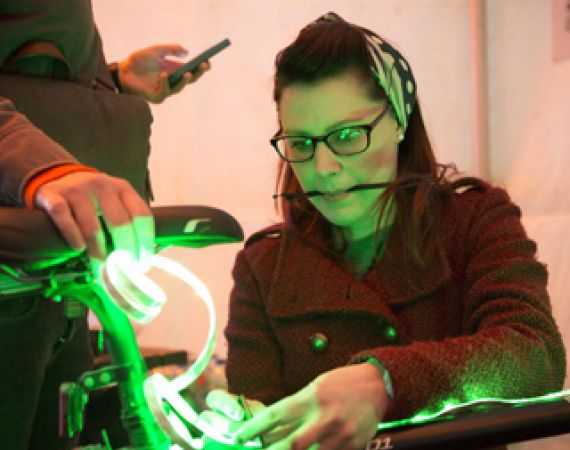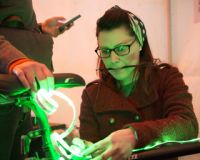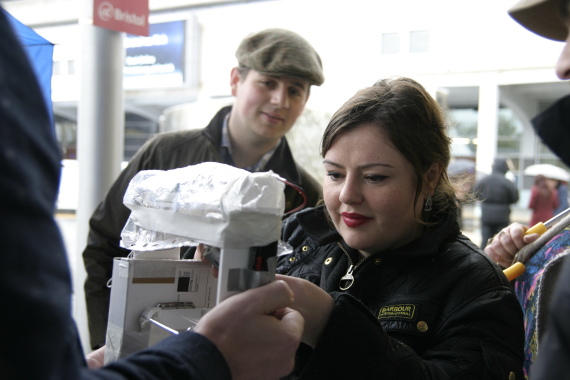Posted on Thu 26 May 2016
Digital Producers Lab, Wales
Laura Cotton adjusts the GPS activated digital harp that the group built.

Posted by
Project

Digital Producers Lab, Wales
Watershed and National Theatre Wales supported 12 brilliant creative Digital Producers through Wales’ very first Digital Producers Lab.
Laura Cotton adjusts the GPS activated digital harp that the group built.
Last week twelve producers from a range of disciplines, all based in Wales, descended on the Pervasive Media Studio, for the Digital Producers Lab we ran in collaboration with National Theatre Wales and the Arts Council of Wales. With a full schedule of speakers and a creative task to be getting on with, the participants had their work cut out.
To start the week, Kate Tyndall, author of The Producers, Alchemists of the Impossible, led a discussion on the role of the producer. At its core the role is one of taking an idea into the world to be experienced. At every point in this process there is a range of people skills, creative skills and finance skills to be employed. They must be able to locate various values and promote the right one to the different audiences, be they funders, peers or the public. This means engaging communities and providing them with opportunities to feel invested in the work. This also means supporting artists, sometimes in the form of hand-holding in order to reassure people that they are making great work and at other times an equally compassionate approach is needed in order to point out areas for improvement.
Katherine Jewkes, Digital Associate at National Theatre Wales, introduced the three ways uses digital technology in productions. First, was using digital to augment a show. This would wrap around the core product and enhance the live experience. Second was the way in which the show is delivered. Live streaming is a particular example of this. Lastly was embedded digital technology, which might include projection or interactive design elements within the show itself. When working with new technologies, recording for posterity allows productions to be repeated with greater ease.
Kim Plowright came along to chat to us about the life cycle of projects - from development to post-release. She described her role as a producer as one of developing structure around creative ideas. Through her discussion of the neuroscience of telling stories, which included the serial position effect and the peak end rule, Kim made it clear that the emotional weight that audiences associate with a product is heavily reliant on how you end projects. Whilst embroiled in the emotional journey of project as a producer, it is important to bear in mind that, if invested, your audiences will also go on an emotional journey. She also stressed the need to be aware that your audience has an audience. Word spreads through social media and often your audience’s first experience of your project will be through a friend or follower. This means that it is important to produce outcomes that are shareable in that way.
Professor Ian Hargreaves proposed a way of looking at the British economy, taking jobs that are directed connected to creative industries and then digging deeper to find creatives embedded in other industries. This research revealed that 2.5 million people are employed by the creative industries or in a creative capacity. This makes the UK’s creative economy a larger employer than either finance or construction. Given that the UK is the biggest user of mobile data, 3rdin the world market for film and games and 4thfor TV content, the clout of the UK’s creative economy is not surprising and understanding this empowers producers.
Caper’s Rachel Coldicutt gave a talk on cultural entrepreneurship. Rachel described her work as partly being a process of making things that people don’t know that they want yet; she explained that part of being a cultural entrepreneur is creating a market for your work. This point fitted nicely with one of the main themes of the week, which has been that producers need to be able to sell projects, whether that is to commissioners, funders or audiences. You need to be excited by projects, and if you’re working collaboratively you need to start that relationship feeling respected. Rachel said that there are times when you must turn work down, if these criteria aren’t being met. Her final tip was to take the time to understand your business’s finances.
Cat John, Marketing and Communications Manager here at the Watershed, discussed the institution’s decision to stop producing a monthly printed brochure. Cat described that other types of communications that the money has since been channelled into. This includes traditionally outdoor media, like banners and billboards, but also Facebook ads. She also spoke about the way digital engagement had been wrapped around the traditional forms, for example running a Twitter campaign linked to the billboards. Creating content that reflects the values of the institution was a key point. It took time to develop the Watershed’s social media voice. Initially this meant assigning the role to one person who honed it over three years but now the approach is embedded across the communications team.
Juliet Bradshaw and Kiera Dales, from TLT Solicitors, gave us a run through of the trepidatious world of copyright, patents, trademarks, design rights and the various types of infringements you could find yourself accused of. It is a challenging line to walk and one that calls on all the skills a Digital Producer needs to cultivate.
Artist Nikki Pugh led the week’s creative task. Tuition began with a run down of Arduino, breadboards and resistors. Flashbacks to GCSE Physics abound, Nikki soon had them on the right path. In the space of an hour the group had built circuits, had LED’s flashing and fading, and some even started editing the code to get different effects. Over the week, the group constructed continued to develop their understanding of Arduino and on Friday afternoon we headed out into the cold and wet for a demonstration of the GPS activated instruments they had built. Amongst these was a digital harp that had to be moved towards Wales in order to play a tune. It was pretty impressive stuff, considering the fact that none of them had ever played with an Arduino before Monday.
We also heard from several of the Pervasive Media Studio’s residents.
- Jo Reid, from Calvium, discussed experience design and user testing drawing on case studies, which included her work with Historic Royal Palaces. This covered the process of testing an app’s interface and ease of navigation but also picking up on where it might drag and listening to more general feedback in order to iterate and refine.
- Sarah Ellis, from Royal Shakespeare Company, spoke about their work with Google on Midsummer Night's Dreaming. In order to explain the collaboration, Sarah posited the RSC as a content maker, regardless of whether content is digital or in a more traditional form.
- Our Digital Producers also had the chance to meet the Pervasive Media Studio’s Magicians in Residence. Now at the halfway point in their residency, Keiron Kirkland and Stuart Nolan shared some of the ideas that they have been developing.
Over the course of the week the network that the Digital Producers had developed became very apparent. We have one more day in Cardiff at the end of the month, where there will be a series of mentoring sessions with individuals from a range of arts institutions.
You can find out more on the week's events using our twitter hashtag #digiproducers or by taking a look at our Storify. You can also read about each day in more detail through a series of blogs posted on National Theatre Wales' website.
